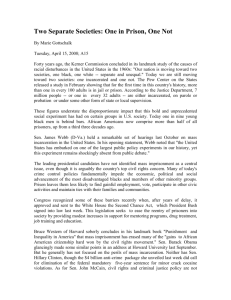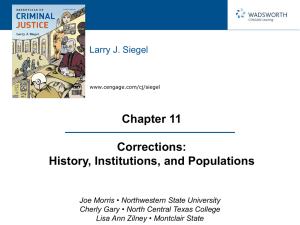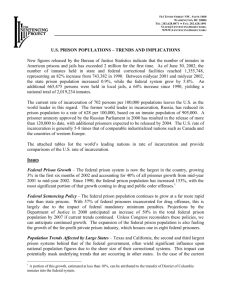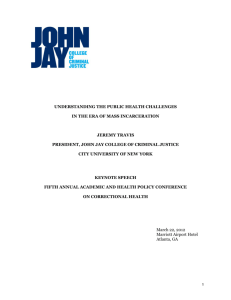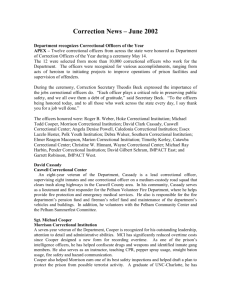The Southwest Journal of Criminal Justice, Vol. 8(2)
advertisement
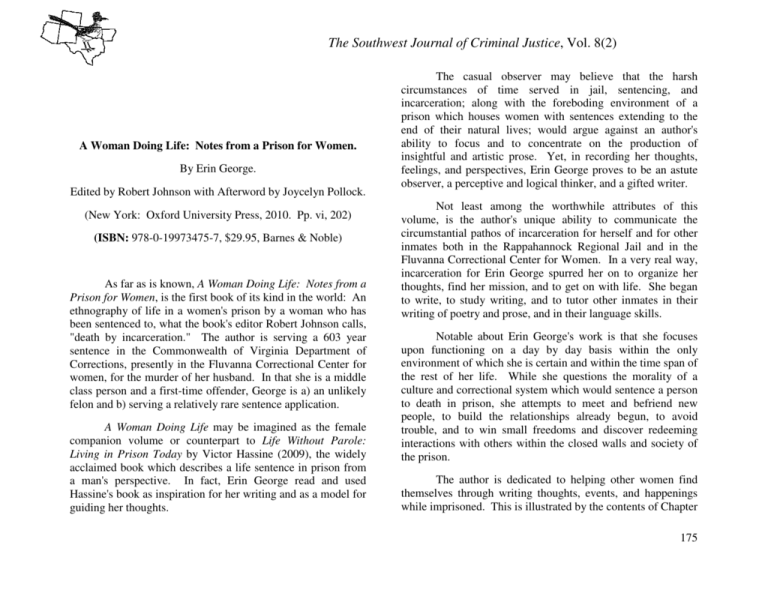
The Southwest Journal of Criminal Justice, Vol. 8(2) A Woman Doing Life: Notes from a Prison for Women. By Erin George. Edited by Robert Johnson with Afterword by Joycelyn Pollock. (New York: Oxford University Press, 2010. Pp. vi, 202) (ISBN: 978-0-19973475-7, $29.95, Barnes & Noble) As far as is known, A Woman Doing Life: Notes from a Prison for Women, is the first book of its kind in the world: An ethnography of life in a women's prison by a woman who has been sentenced to, what the book's editor Robert Johnson calls, "death by incarceration." The author is serving a 603 year sentence in the Commonwealth of Virginia Department of Corrections, presently in the Fluvanna Correctional Center for women, for the murder of her husband. In that she is a middle class person and a first-time offender, George is a) an unlikely felon and b) serving a relatively rare sentence application. A Woman Doing Life may be imagined as the female companion volume or counterpart to Life Without Parole: Living in Prison Today by Victor Hassine (2009), the widely acclaimed book which describes a life sentence in prison from a man's perspective. In fact, Erin George read and used Hassine's book as inspiration for her writing and as a model for guiding her thoughts. The casual observer may believe that the harsh circumstances of time served in jail, sentencing, and incarceration; along with the foreboding environment of a prison which houses women with sentences extending to the end of their natural lives; would argue against an author's ability to focus and to concentrate on the production of insightful and artistic prose. Yet, in recording her thoughts, feelings, and perspectives, Erin George proves to be an astute observer, a perceptive and logical thinker, and a gifted writer. Not least among the worthwhile attributes of this volume, is the author's unique ability to communicate the circumstantial pathos of incarceration for herself and for other inmates both in the Rappahannock Regional Jail and in the Fluvanna Correctional Center for Women. In a very real way, incarceration for Erin George spurred her on to organize her thoughts, find her mission, and to get on with life. She began to write, to study writing, and to tutor other inmates in their writing of poetry and prose, and in their language skills. Notable about Erin George's work is that she focuses upon functioning on a day by day basis within the only environment of which she is certain and within the time span of the rest of her life. While she questions the morality of a culture and correctional system which would sentence a person to death in prison, she attempts to meet and befriend new people, to build the relationships already begun, to avoid trouble, and to win small freedoms and discover redeeming interactions with others within the closed walls and society of the prison. The author is dedicated to helping other women find themselves through writing thoughts, events, and happenings while imprisoned. This is illustrated by the contents of Chapter 175 The Southwest Journal of Criminal Justice, Vol. 8(2) 10 (Pp., 141 to 153) in which Erin George has asked other women inmates to write essays to help her more fully convey a picture of women's lives while incarcerated and the troubles, stumbling blocks, and promises encountered in prison experience. Some of the experiences and conditions she shares will surprise even those who study in or teach correctional courses. For one thought-provoking example, George tells of the incredibly poor quality of the garments issued to her by the state prison system of Virginia. Receiving two pair of undergarments as her initial allotment, the first pair fell apart before the end of her first day; and the second were as long lived. This episode was only one of many experiences and observations in prison which caused the author to raise the question: Are those who provide garments and services in the 21st Century still following the habit of those in the 19th Century who became rich by providing the prison inmates with fewer goods, less food, and fewer services than those for which the state was paying them? academy, and gives a valuable apologetics regarding the credibility of the author's observations and conclusions. It is suggested that A Woman Doing Life could be used in the college classroom, as a companion to a primary textbook. Thus the student may glimpse the faces of hope, loss, and fear -- the basic human attitudes or emotions which prison life tends to intensify. Edward J. Schauer Prairie View A&M University The book itself is well set off, as if with parentheses, by the excellent introduction and afterward by two accomplished writers and recognized correctional experts: First, Robert Johnson, editor of this volume as well as of the 2011 fifth edition and posthumous issue of Victor Hassine's Life Without Parole, has introduced and summarized A Woman Doing Life in a short, pithy, and intellectually stimulating essay. Second, Joycelyn Pollock, a researcher and scholar who has frequently published on the subjects of women and corrections, adds much insight in the afterward as to how the organization and information of this volume fits in the twin literatures of corrections and feminism. She explains how the book may be used as a companion textbook supporting courses in the 176


